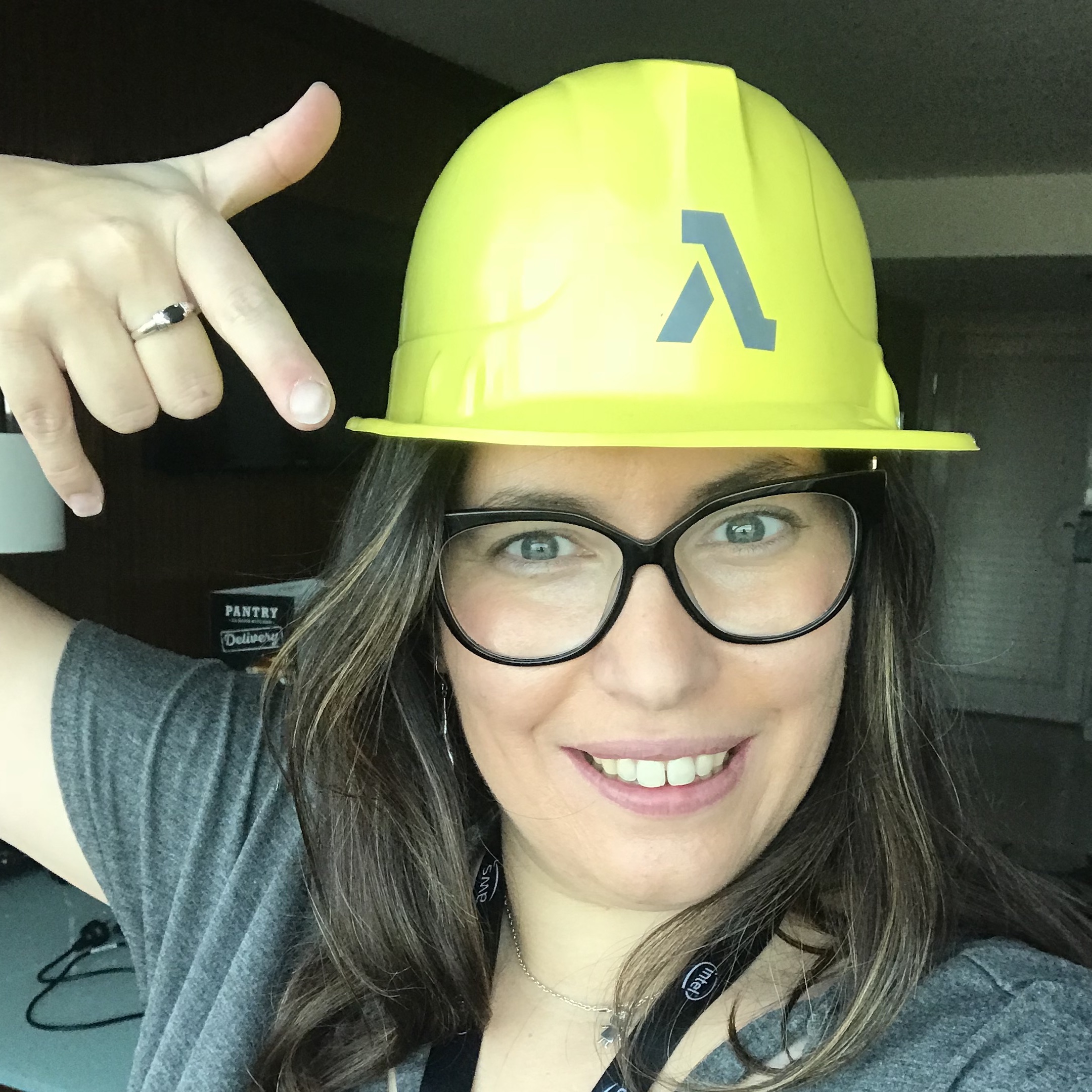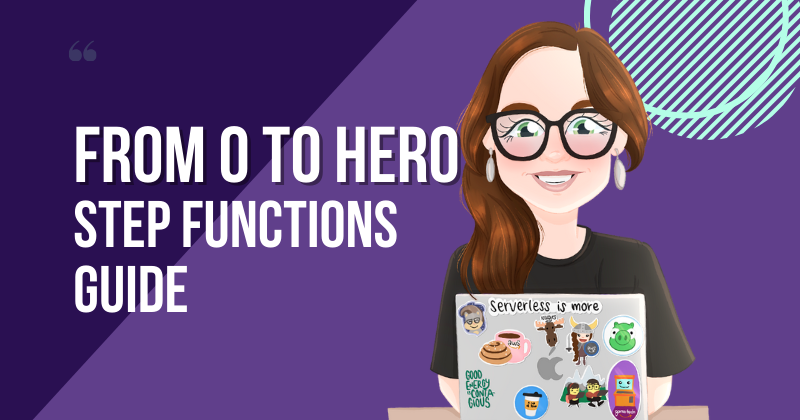The ultimate AWS Step Functions guide
 Marcia Villalba
Marcia Villalba
In this guide, you will go from zero to hero in your AWS Step Functions knowledge. If you are just getting started or you are already using this service, you will find for sure something for you.
The guide is free and divided into different sections for you to find the content easily.
The first section - Introduction - is ideal for beginners as it will go into what AWS Step Functions is and all the terms that the rest of the guide will use.
The second section - Features - is ideal for everybody that wants to learn the basic features that AWS Step Functions provides out of the box. Later in the guide, there is a section with more advanced features.
The third section is about Integration Patterns. One of the main advantages of Step Functions is that it can integrate with over 200 AWS services, as well as external services and manual process. In this section, you will learn how that is done.
The fourth section is about costs. This is a section that everybody should watch as in this part of the guide we go into detail on how the different workflows are charged as well as how you can optimize your workflows with costs in mind.
The fifth section is about developing applications using AWS Step Functions. Here you will learn how to do it with infrastructure as code - AWS SAM or AWS CDK. And many features that will help you in the development like IDE tools and testing capabilities.
The sixth section is all about the more advanced and specific features that AWS Step Functions offer. This is a great section if you have to solve one particular problem or you want to become an expert in the service.
The last section is all about examples and patterns using AWS Step Functions. Here you can see different architectures that were built using this service and how the problems were solved. This is a great section for more advanced users and for people that are already building applications with this service.
1. Introduction
This section is ideal for beginners as it will go into what AWS Step Functions is and all the terms that you need to know in order to follow along the guide.
In this first video, you will learn what AWS Step Functions are, what are the main use cases and benefits.
In this video, dive deep into AWS Step Functions, exploring key concepts such as types of states, and how they are visually represented. It covers the eight types of states, and state management. It talks about the different workflows (standard and express) and when to use each.
This video explains the distributed map state in more detail, that allows you to write Step Functions to coordinate large-scale parallel workloads within your serverless applications. You can iterate over millions of objects such as logs, images, or .csv files stored in Amazon S3. The distributed map state can launch up to ten thousand parallel workflows to process data.
If you want to learn more about the distributed map state and how some companies are using it, check this blog post where I talk with CyberGRX about their solution.
2. Basic features
This section is ideal for everybody that wants to learn the basic features that AWS Step Functions provides out of the box. Later in the guide, there is a section with more advanced features.
Intrinsic functions
The Amazon States Language provides several intrinsic functions, also known as intrinsic, that help you perform basic data processing operations without using a Task state. Intrinsic are constructs that look similar to functions in programming languages. They can be used to help payload builders process the data going to and from the Resource field of a Task state.
Error handling
One of the best features of Step Functions is all the different mechanisms that it provides for error handling. In this video, you will learn about Step Functions error handling mechanisms: retries, fallback states, and redrive.
3. Integration patterns
This section is about Integration Patterns. One of the main advantages of Step Functions is that it can integrate with over 200 AWS services, as well as external services and manual process. In this section, you will learn how that is done.
In this first video, you will learn about the three integration patterns available in Step Functions and when to use each.
In this video, you will see an example - with code demo about the integration pattern to run a synchronous job.
In this video, you will see an example - with code demo about the integration pattern to wait for a callback.
4. Costs
Understanding costs and how much the different AWS resources cost us is an important part of the architect job. In this video, Ben Smith, Developer Advocate for AWS, talks about how the different Step Functions workflows are priced and how you can do interesting optimizations to get the best price you can from running your workflows.
5. Building and developing Step Functions
There are many ways to build and develop Step Functions. You can build them from the console or as code. In this section, you will learn the different options you have to build them.
The first video shows the Step Function Workflow Studio. In my opinion one of the best UIs in the AWS Console. The Workflow Studio is a tool that helps you to build workflows visually.
If you like to work with your workflows as infrastructure as code, you might be interested in this other video, where you can learn how to create workflows using AWS SAM and ASL (Amazon State Language).
Also, you might be interested in using AWS CDK to build your workflows, and this video shows you the native AWS CDK way to build the workflows and also how to integrate the ASL template into your CDK application.
If you like to use Workflow Studio from your IDE, you can use it from Visual Studio Code if you are using AppComposer. This video shows how you can do it.
Now that you know how to build and develop your workflows, you might need to test them and debug them. If you are using the AWS Console and Workflow Studio, you can take advantage of the visual capability of debugging the workflows.
Also, if you are using Workflow Studio, you can use the Test State functionality that allows you to test every state before deploying the workflow. This is really handy when building complex integrations when you want to test permissions, payloads, and intrinsic functions.
And finally, if you are into writing unit tests for your workflows, Step Function provides a framework called Mocked Service Integrations that allows you to write this kind of tests and keep them as code in your repository. Unit tests are always a good practice when you are building any kind of application. You can use them to make sure that all the changes you don't break the existing functionality.
6. Advanced features
This section is all about advanced and specific features that AWS Step Functions offer. This is a great section if you have to solve one particular problem or you want to become an expert in the service.
One feature that I won't call it advanced but I want to mention here is the capability of Step Functions to integrate with over 200 AWS Services natively, without the need to use a function in the middle. This video shows more about this integration.
If you need to invoke an external HTTP Endpoint and you don't want to use a Lambda function, you can do this directly from the workflow, using the new HTTPs endpoint task state. In this video, you will learn how to use it.
For the ones using Generative Artificial Inteligence in their applications, you can integrate Amazon Bedrock directly to your workflows. This video shows you how.
If you need to have multiple versions of the same workflow available, for example, for your deployment stages, you can take advantage of this feature of Alias and Versions that Step Functions provides. You can update independent versions of the workflow and have alias pointing to the right version you are interested. This video shows you how to do it.
7. Patterns and useful architectures
This last section is all about example architectures and patterns using AWS Step Functions. Here you can find different architectures that were built using this service and how the problems were solved.
The first video is a conversation with Ben Smith, Developer Advocate for AWS, in where he presents a series of very useful patterns that you can use in your applications to make them better and to solve complex problems easily.
This video is an example of an asynchronous application for transforming content with AI. You will learn how to embrace event-driven architectures and how the different concepts that were exposed earlier in this post come together into one architecture.
This video shows how to build a synchronous workflow using Step Functions and API Gateway. In this way, Step Functions can be the backend for your APIs.
This video explains the Saga pattern and how to implement it using Step Functions.
In this video, James Beswick, Developer Advocate for AWS, explains how Serverlesspresso uses Step Functions and EventBridge to orchestrate the different coffee orders.
8. Conclusion
And with that, you arrived at the end of the guide. Congrats!
By now, you should have enough information to start building your own applications using Step Functions.
In this comprehensive guide, you will learn everything from the basics to advanced features of AWS Step Functions, including integration patterns, costs, development options, and real-world examples. Ideal for beginners and experienced users alike, this guide covers all you need to know to start building applications with Step Functions.
If you want to get notified regularly when I create new content like this, you can subscribe to my newsletter.
And please share this article if you find it useful!
Subscribe to my newsletter
Read articles from Marcia Villalba directly inside your inbox. Subscribe to the newsletter, and don't miss out.
Written by

Marcia Villalba
Marcia Villalba
Developer Advocate at AWS | Serverless <3